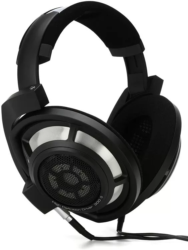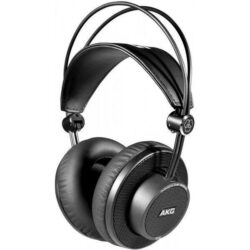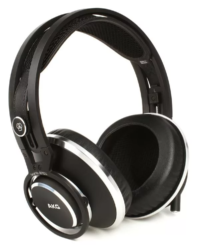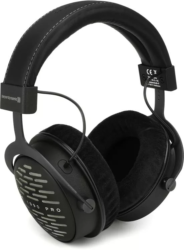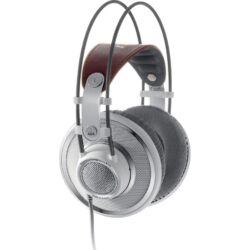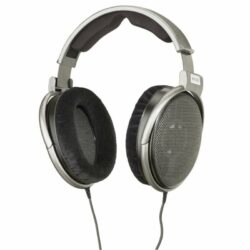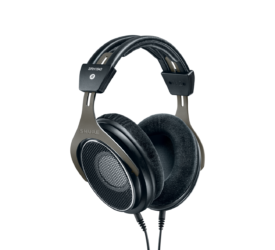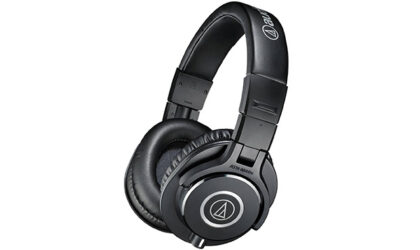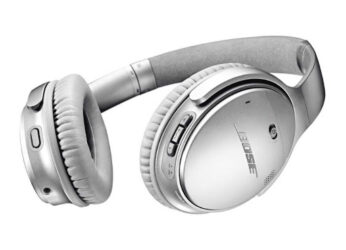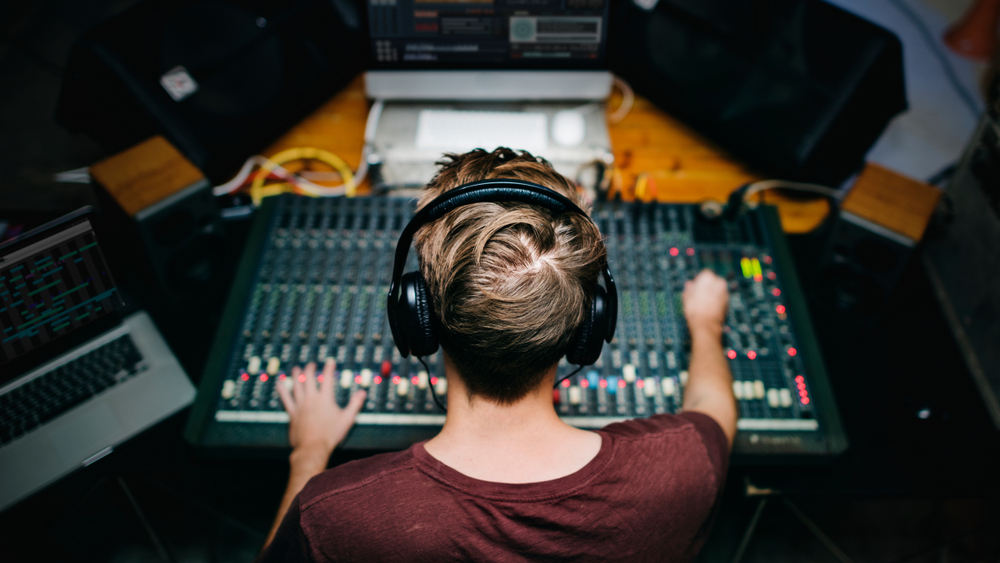These days, anyone with a computer is capable of getting their hands on the same audio engineering tools as the real pros. You can install them on laptops or even phones, making producing on the go a real possibility for the first time. What was once something you had to do sitting down in front of thousands of dollars of bulky and immobile equipment is now possible almost anywhere, even places you can’t set up monitors.
Whether you’re a studio engineer, a music producer, or just interested in getting the purest sound possible, there’s never been a better time than now to start exploring everything studio reference headphones can offer.
- Evaluating Reference Headphones
- Top 10 Best Headphones for Mixing and Mastering 2025
- 1. Best Overall Mixing Headphones: Audio-Technica ATH R70x
- 2. Best Premium Mixing Headphones: Sennheiser HD 800S
- 3. Best Budget Mixing Headphones: AKG K245
- 4. Best Closed-Back Mixing Headphones: AKG K872
- 5. Most Durable Open-Backed Mixing Headphones: Beyerdynamic DT 1990 Pro
- 6. Most Ergonomic Mixing Headphones: AKG K701
- 7. Most Versatile Mixing Headphones: Sennheiser HD 650
- 8. Best Headphones for Analytical Mixing: Shure SRH1840
- 9. Best Entry-Level Mixing Headphones: Audio-Technica ATH M40x
- 10. Best Wireless Mixing Headphones: Bose QuietComfort 35 II
- Mixing Headphones FAQ
- Guide to Mixing and Mastering Headphones
- Final Thoughts
Evaluating Reference Headphones
The best way to evaluate the awesome selection of cans out there these days is to get your hands on a demo model and give it a good listen. We know that’s not always possible to do, though, so we’ve done our best to deliver useful, bite-sized reviews on some of the highest quality headphones available. Here’s how we broke it down.
Factors to Consider When Choosing Headphones
Our reviews on these headphones are meant to get straight to what you want to know as quickly as possible. We’ve listed everything you need to know about the technical specs first, sourced from the manufacturers themselves (or the next best thing, when dealing with Bose-brand equipment).
- Open/Closed: Whether the headphones are open or closed-back design. Closed-back headphones isolate noise for greater clarity, while open headphones are more comfortable and some prefer their more natural sound.
- Impedance: How much power it takes to run the headphones. Lower numbers (typically below 50 ohms) work with smaller devices like phones, while headphones with impedance much greater than 50 ohms will usually need a dedicated amplifier.
- Frequency Response: The range of frequencies the headphones are capable of outputting, from lowest to highest. Most people can hear frequencies between 20 to 20,000 Hz (which is sometimes written as 20 kHz), though you’ll also be able to notice sub-20 Hz bass frequencies.
- Sensitivity: How loud the headphones are when supplied with the same voltage power. Not a standardized number, so it’s difficult to compare between headphones. This is closely related to volume: 100 dB is typically fine for most users, but anyone who loves to play it loud will want to look for something closer to 120.
- Driver Type: The type of drivers in the headphones. Usually magnetic (powerful and bassy) or dynamic (balanced and affordable but sometimes distorted at high volumes), though there are unique proprietary technologies too.
- Driver Diameter: The size of the drivers. Generally between 40 and 55 mm, and doesn’t affect headphones nearly as much as larger speakers. Larger drivers will be able to produce louder sounds, but they’ll also offer slightly worse performance at high frequencies.
- Cable Type & Length: These show the type of cable or cables included, as well as how long they are and if they’re replaceable or not.
- Plug Size: Which plugs and adaptors the headphones include. 1/8“s are standard headphone jacks, also known as stereo jacks. 1/4“ plugs are found on amps and studio equipment, also known as guitar jacks.
- Weight: The weight of the headphones, usually without the cable included.
We’ve also split up the reviews themselves into two sections, each focusing on the two most important aspects of a good set of studio cans.
Sound Quality
In this section we note what we think of the headphone’s overall sound quality and how the design hurts or helps this. This is where you’ll find information about how flat the response curve is or how wide the soundstage, so if you’re curious about the experience of actually listening to them, don’t skip it.
Comfort
Here you can read all about how the headphones feel on your head, from clamping force to the quality of the ear pads. We’ll also mention anything notable about the cables or the rest of the build that could impact how long you can comfortably wear a pair.
Run into a term you’re unfamiliar with? Don’t worry, after our reviews we have an in-depth guide on everything you need to know about choosing headphones for mixing and mastering.
Since we’ve primed you on how we judged each of these picks, it’s time to get the show on the road. Continue on for our reviews of some of our favorite studio headphones on the market.
Top 10 Best Headphones for Mixing and Mastering 2025
1. Best Overall Mixing Headphones: Audio-Technica ATH R70x
Why we like it:
This is a top-notch, professional quality pair of headphones used by producers and engineers around the world that manages to stay affordable without sacrificing any quality, putting it firmly in that sweet spot that makes it our overall favorite.
Quick Specs:
- Open/ClosedOpen
- Impedance420 ohms
- Frequency Response5 Hz – 40 kHz
- Sensitivity99 dB
- Driver45 mm dynamic
- Cable10 ft. straight, replaceable
- Plug Size1/8″ plug, 1/4″ adapter
- Weight0.46 lbs
Sound Quality
Audio-Technica is a Japanese manufacturer whose name speaks for itself. They’ve supplied audio equipment to big-name TV shows like Big Brother and Deal or No Deal, plus their headphones and microphones have been used at almost every Olympic Games event since 1996. When we say the ATH R70x lives up to its reputation, we mean it.
The flat response, wide frequency range, and wide-open soundstage combine into a near-perfect environment for mixing and mastering, as long as you have the power to run it. You’ll definitely need an amplifier for this one.
Comfort
The spring-loaded cushioned arms that rest on your head are adjustable using the metal band above them, leaving the clamping force entirely in your hands. Combined with such a lightweight build and a lengthy cable, you could easily keep these on all day while you move around your studio.
It automatically detects the orientation of the headphones, so you’ll never have to worry if your left and right channels are wrong again. We wish the pads were a bit larger, though, as they can be uncomfortable for those with larger than average ears—the similar open-backed Beyerdynamic DT 1990 Pro features two sets of pads to ensure a better fit if these won’t fit right.
Our Verdict
Overall, you can’t go wrong with choosing the R70xs unless you’re lacking in power supply. With accuracy rivaling even the vastly more expensive Sennheiser HD 800 S headphones, they’re a great choice whether you’re adding to a professional studio or just your bedroom.
Pros
- Great, wide-open soundstage with seriously nice stereo imaging
- Extremely flat response perfect for picking out fine details
- Adjustable clamping force means a comfortable fit on any head
- Automatically senses right and left orientation
- Very reasonably priced for the sound quality
Cons
- Very power hungry
- Ear pads could be bigger
Why we like it:
For those with the budget for it, the Sennheiser HD 800S might be the apex headphones when it comes to audio engineering. To call them premium almost feels like an understatement.
Quick Specs:
- Open/ClosedOpen
- Impedance300 ohms
- Frequency Response4 Hz – 51 kHz
- Sensitivity103 dB
- Driver56 mm dynamic
- Cable9.8 ft straight, replaceable
- Plug Size¼”
- Weight0.73 lbs
Sound Quality
The HD 800S delivers an awe-inspiring soundstage with ridiculously good imaging accuracy. For audio engineers who do a lot of panning and instrument placement work these headphones are like a dream come true. It’s been compared by professionals and reviewers alike to actually using studio monitors, and we’d have to agree.
There is a small hang up in all this awesomeness, though. Without any amplifiers or software altering the sound, the high-end comes in noticeably bright. Part of the upgrade to the 800S involved taming the treble, so it’s disappointing there’s still an issue here.
Comfort
Once you’ve got these headphones on right, they’re comfortable and light enough in both weight and clamping force to feel almost like they aren’t there. The catch is you’ve got to figure out how to get them on right, which can be unfortunately tricky thanks to the large ear pads and short headband area. Though not quite as premium in other areas, the AKG K701 comes out on top in terms of comfort.
Our Verdict
Like its similarly priced closed-back competitor, the AKG K872s, the hefty price tag on these headphones sounds a lot more reasonable when you realize how much you’d be spending on monitors and room treatment that can beat this kind of quality.
Despite some issues with the frequency response curve that can be solved with software or certain amplifiers, the Sennheiser HD 800Ss are a welcome and premium addition to any audio engineer’s studio.
Pros
- Amazing resolution and accuracy
- Incredibly realistic soundstage and top-of-the-line stereo imaging
- Awesome build quality and style
- Closely rivals using actual studio monitors
Cons
- Response isn’t as flat as it could be, treble in particular
- Can be tricky to make comfortable
3. Best Budget Mixing Headphones: AKG K245
Why we like it:
AKG’s K245 is the open-backed entry in their budget line that sports respectable sound quality at a great price, ensuring there’s a decent mixing and mastering headphones option no matter your price range.
Quick Specs:
- Open/ClosedOpen
- Impedance32 ohms
- Frequency Response15 Hz – 25 kHz
- Sensitivity109 dB
- Driver50 mm dynamic
- Cable16.4 ft coiled, replaceable
- Plug Size1/8" plug, 1/4" adapter
- Weight0.65 lbs
Sound Quality
Aside from bass coming in hot, for such inexpensive headphones the frequency response is surprisingly neutral and lacking in coloration, though if you take time to learn the characteristics of the K245s that coloration is worked around easily enough. The sound isolation is excellent for open-backed headphones – that kind of best of both worlds quality is hard to find.
Comfort
For somebody with a smaller-sized head, or maybe a child, these headphones are as comfortable as any other in their range. The long coiled cable even gives you plenty of movement slack.
For anyone larger than that, though, the clamping force can be headache-inducing, if you can even get the thin and easily torn ear pads positioned right in the first place. If your head is above average size, you’re going to want to pass on these outright and choose something larger like the Shure SRH1840.
Our Verdict
In the audio world, you get the quality you pay for most of the time. Thankfully, budget cans like the K245s like to come along and buck that trend from time to time. They obviously aren’t going to blow you away like Audio-Technica’s R70xs. But for a very reasonable price you’re getting a tough, foldable pair of headphones you can feel safe bringing outside the safety of your home. We only wish they made them in a larger size.
Pros
- Respectable sound quality at a budget price
- Durable build makes these safer to take on the go
- Good sound isolation for open-back headphones
- Coiled cable can stretch clear across a room with ease
Cons
- On the small side, very uncomfortable for larger heads
- Ear pads wear out easily
- Somewhat heavy on the bass end
4. Best Closed-Back Mixing Headphones: AKG K872
Why we like it:
Proving mixing and mastering isn’t just an open-backed game: the K872s are tailor-made for audio engineers looking for awesome performance with a very low power demand and excellent isolation.
Quick Specs:
- Open/ClosedClosed
- Impedance36 ohms
- Frequency Response5 Hz – 54 kHz
- Sensitivity112 dB
- Driver53 mm magnetic
- Cable9.8 ft straight, replaceable
- Plug Size1/8" plug, 1/4" adapter
- Weight0.86 lbs
Sound Quality
Something of a jack-of-all-trades, the sound isolation and clarity of the K872s make them at home no matter what you’re up to in the studio. That makes the low impedance especially awesome, because you can plug them into almost anything without running into power draw issues.
It’s impossible to avoid coloration from closed-back headphones, but AKG’s design mitigates that as much as possible, leaving you alone with the music thanks to the great sound isolation.
Comfort
The clamping force of these headphones manages to be both firm enough to keep it on your head, but light enough it feels like it’s barely touching at the same time. They’re easily adjustable and will fit heads of all shapes and sizes just as well for hours, scoring huge points in the ergonomic category.
Our Verdict
It’s said you shouldn’t even think about using closed-back studio headphones for anything but recording and tracking. We wouldn’t be surprised if we found out AKG set out specifically to disprove that theory with the K872s. Our only real gripe with these headphones is the lacking response curve. The significantly cheaper K701s – also by AKG – make us wonder why AKG took the step backwards, and are a good alternative choice for anyone who prizes a good response curve over this otherwise superior model.
Pros
- Great for every job in the studio, from mixing to tracking and recording
- Brilliant accuracy with very low impedance - this will even work on your phone
- Produces a natural, clear sound after a breaking in period
- Excellent sound isolation, perfect for shutting out external noise
- Comes with a hardshell carrying case, more protective than a simple bag
Cons
- Lacks in response curve compared to cheaper AKG models
- Soundstage still lacking compared to open-backed headphones
5. Most Durable Open-Backed Mixing Headphones: Beyerdynamic DT 1990 Pro
Why we like it:
Fueled by Beyerdynamic’s powerful Tesla magnet drivers, this snappy pair of high-quality aggressive headphones is built to last.
Quick Specs:
- Open/ClosedOpen
- Impedance250 ohms
- Frequency Response5 Hz – 40 kHz
- Sensitivity102 dB
- Driver45 mm magnetic
- Cable Type9.8 ft coiled & 16.4 ft straight, replaceable
- Plug Size1/8" plug, 1/4" adapter
- Weight.81 lbs
Sound Quality
No top ten headphone list would be complete without Beyerdynamic’s name on it. The DT 1990s are a direct upgrade to the more budget-friendly DT-990 Pros in almost every respect. It’s like the inverse of the Sennheiser HD 650s – an upfront presentation with a V-shaped response curve that emphasizes the bass and treble while moving mids in the background.
If durability isn’t your main concern, choosing between these two pairs of headphones is almost entirely personal preference, as they both feature amazing depth and accuracy in their price range.
Comfort
Though a little on the heavy side for open-backed headphones, the DT 1990s are still no slouch in the comfort department. The analytical set of pads is softer and less heavy on the clamp force than the balanced pads, which is great for those long nights spent on a mix. It would be nice if it were less of a pain to swap these out, though, because as it is you generally stick one set on and leave it no matter what you’re doing.
Our Verdict
The only open-back cans that compete with it on the durability front are the AKG K245s and Shure SRH1840s, and it’s frankly no contest on the audio quality front between the former and the DT 1990s. The soundstage can get a bit box-shaped because of the less open design, and we think if your headphones include ear pad swapping as a feature it should be a lot easier than this.
Pros
- Upfront, almost aggressive bass depth and treble clarity
- Built like a tank, much more durable than similar quality headphones
- Multiple options for cables included, as well as a convenient hard case
- Includes two sets of ear pads with differing characteristics
Cons
- Drivers are isolated enough it’s more semi-open than open-backed
- Swapping out the ear pads isn’t as convenient as it could be
6. Most Ergonomic Mixing Headphones: AKG K701
Why we like it:
Featuring comfortable ergonomic, accurate soundstaging, and an amazingly flat response curve, there’s more than one good reason the K701s are well regarded by professionals and hobbyists alike.
Quick Specs:
- Open/ClosedOpen
- Impedance62 ohms
- Frequency Response10 Hz - 39.8 kHz
- Sensitivity105 dB
- Driver45 mm magnetic
- Cable9.8 ft straight
- Plug Size1/8" plug, 1/4" adapter
- Weight0.52 lbs
Sound Quality
Despite being an older model compared to the AKG 712s, the K701s have a nearly completely linear response curve the newer models lack. This is one of the most important things to look for in a good pair of mixing cans and AKG has absolutely knocked it out of the part here.
Every bit of sound that comes out of them is lush and pure, putting the perfect mixdown in your hands every time. It doesn’t demand much power to work at full capacity either. Quincy Jones, the man who produced three of Michael Jackson’s most famous albums, liked these headphones so much he endorsed an entire line of them.
Comfort
Ergonomic headphones are difficult to do right thanks to the vast array of unique head shapes and sizes out there. AKG really managed to impress on this front with the huge 3D-Form ear pads that fit comfortably over any sized ears. You won’t need to worry about fiddling with the headband to get it to sit right either – it’s self adjusting, bending and flexing to provide maximum comfort and ergonomics no matter how you’ve got it on your head.
Our Verdict
Not only are these comfortable, they pack a linear response curve that competes with the very best of the competition, like the ATH R70xs. With all of this quality, we were surprised to find the cable itself isn’t replaceable. It seems like a big oversight on an otherwise incredible pair of studio cans.
Pros
- Very flat response curve is perfect for audio engineering
- Self-adjusting headband and 3D-form ear pads make for top tier comfort
- Mid-range power requirements don’t demand a lot
Cons
- Non-replaceable cable means once it starts malfunctioning, you need a new pair
7. Most Versatile Mixing Headphones: Sennheiser HD 650
Why we like it:
A time-tested classic, years after their original release there’s plenty of reasons the Sennheiser HD 650s are still one of the top choices in studio headphones.
Quick Specs:
- Open/ClosedOpen
- Impedance300 ohms
- Frequency Response10 Hz – 41 kHz
- Sensitivity103 dB
- Driver40 mm dynamic
- Cable9.8 ft straight
- Plug Size1/4" plug, 1/8" adapter
- Weight.57 lbs
Sound Quality
A lot has been said over the years about the HD 650s’ sound quality, and almost all of it has been good. They don’t stand out as much when it comes to stereo imaging, but make up for it with a sweeping, high-resolution response range that brings out every last detail of a mix.
Unlike more aggressively tuned cans, the audio output is smooth and laidback making it easy to go hours without losing fine details to ear fatigue. Thanks to the excellent transparency and the drivers being an inch away from your ears, if you close your eyes you might forget you’re wearing headphones.
There is some notable dark coloration to the sound in the low end. Sennheiser designed these headphones to work well for both audiophile and audio engineering purposes, so there are trade-offs if you’re looking for the flattest response curve possible, and something like the Audio-Technica ATH R70x might be a better choice if that’s what you prefer.
Comfort
With luxurious velour ear pads that rest gently over your ears, the HD 650s are designed for long-term comfort and it shows. For the average wearer, they rest lightly enough that even glasses won’t cause pain over time. But at a certain size, the clamp force makes itself known. Troubles with larger-sized heads aren’t uncommon, but we wish more manufacturers had solutions to them like AKG’s approach with the K701.
Our Verdict
You can thank the HD 650s for helping open the door to all the great, affordable mixing headphones on the market today. These headphones are good enough they’ve been singled out as a threshold of diminishing returns – you can pay ten times more than them, but you won’t be getting ten times the quality.
They aren’t as far from their premium sibling, the HD 800S, as the prices would suggest. It’s hard to go wrong picking yourself up a pair.
Pros
- Relaxed voicing that won’t fatigue your ears as quickly
- Impeccable accuracy - you can hear every detail of a mix, good or bad
- Great transparency, easy to forget you’re listening to headphones
- Multi-purpose - works as reference and audiophile headphones alike
Cons
- Average stereo imaging capabilities
- Noticeable dark coloration in the bass frequencies
- Clamping force is a little strong on larger heads
8. Best Headphones for Analytical Mixing: Shure SRH1840
Why we like it:
Durable, reliable, and easily driven with most amplifiers no matter the size, the Shure SRH1840 is a great alternative to more well-known cans for those looking for something sturdy and analytical.
Quick Specs:
- Open/ClosedOpen
- Impedance65 ohms
- Frequency Response10 Hz – 30 kHz
- Sensitivity96 dB
- Driver40 mm dynamic
- Cable6.9 ft straight, replaceable
- Plug Size1/8" plug, 1/4" adapter
- Weight0.59 lbs
Sound Quality
There’s no shortage of amazing high-end headphones these days, dominated by the big names like Sennheiser and AKG. But Shure, a nearly 100-year-old audio equipment company, isn’t about to be left out of the fun. You get a crystal clear sound out of these with impressive neutrality – exactly what you’re looking for in mixing and mastering cans.
It seems Shure was looking to target both studio and live use cases with these headphones, but as open-back headphones, they lack the sound isolation qualities that make headphones work in that setting.
The largest strikes against the SRH1840s are the surprisingly high distortion for such expensive and otherwise impressive headphones and the somewhat boxed-in soundstage. They’re no five dollar earbuds, but it’s still a head scratcher as to why they came out like this. They’re perfect for mixdowns, but someone looking for more well-rounded open headphones would likely prefer the Sennheiser HD 800S.
Comfort
A single glance at those lush velour ear pads speaks volumes about how comfortable the SRH1840s are to wear. Thanks to the smartly designed headband, the clamping force never becomes an issue even on larger heads. That headband is also a little concerning to us, though – there doesn’t seem to be a way to replace it if it starts wearing out.
Our Verdict
They’re much easier to drive than the Sennheiser HD 650s but very comparable in sound quality, making these a perfect choice for those who don’t already have a powerful amplifier on hand. Minor distortion issues and some build design choices are the only thing that holds these headphones back from truly competing with the best.
Pros
- Built strong, but lightweight
- Highly analytical and technical sound - perfect for mixdowns
- Intended for both studio and live performances
- Comes with replacement pads and cables out of the box
Cons
- Soundstage is somewhat boxy
- Distortion levels surprisingly high for high-end headphones
- Leather headband isn’t replaceable, but is prone to wearing out
9. Best Entry-Level Mixing Headphones: Audio-Technica ATH M40x
Why we like it:
The M40x headphones are perfect for anyone interested in mixing with headphones but not sure they want a completely dedicated pair or to break the bank just to find out if they like it or not.
Quick Specs:
- Open/ClosedClosed
- Impedance35 ohms
- Frequency Response15 Hz – 24 kHz
- Sensitivity98 dB
- Driver40 mm dynamic
- Cable9.8 ft straight and coiled, replaceable
- Plug Size1/8" plug, 1/4" adapter
- Weight0.53 lbs
Sound Quality
Though it still has the shortcomings typical of closed-back headphones, Audio-Technica’s entry-level range of headphones will still serve you well in a studio setting, especially for those dabbling in home electronic music production. If you can adapt to the way the bass can muddy and color the sealed environment, you’ll find an impressively flat response for such basic cans.
That being said, the sound isolation doesn’t come in as strong as it does with other closed-back headphones we reviewed, like Bose’s QuietComforts, and you’ll likely experience sound bleeding both into and out of the ear pads while in use.
Comfort
A gentle clamping force that doesn’t feel like it’s squeezing at all defines these headphones, but if you wear glasses you may still find them uncomfortable after a long period—something open like the Sennheiser HD 650 is really a safer bet for glasses-wearers. They’re capable of folding in on themselves, making them great for traveling, but unlike the ATH M50xs the ear cups only pivot 90 degrees instead of a full 180, making them harder to use in DJing situations.
Our Verdict
We chose these as our pick for entry-level mixing headphones because they deliver a fairly flat response curve at a reasonable price, but can still be used as a daily pair of headphones. So it’s perfect for somebody looking for a taste of the hi-fi realm without breaking the bank or losing the sound isolation of closed-back headphones. You may also want to consider the AKG K245s if you’re interested in hearing what open-backed headphones are like.
Pros
- Great way to get your feet wet when it comes to reference headphones
- Very reasonable price point for such a flat response
- Will work just as well while gaming or watching movies as in the studio
- Excellent traveling headphones
Cons
- Close-backed design can cause bass frequencies to build up and muddy sound
- Cups only swivel 90 degrees instead of a full 180
- Sound isolation isn’t anything to write home about
10. Best Wireless Mixing Headphones: Bose QuietComfort 35 II
Why we like it:
Bose’s QuietComfort is a comfortable, high-performance pair of Bluetooth wireless headphones that manages to deliver a reliable timbre that’s easy to mix with. Combine that with the unique active noise canceling features and you have a great if somewhat unconventional choice for wireless studio headphones.
Quick Specs:
- Open/ClosedClosed
- ImpedanceN/A
- Frequency Response10 Hz – 20 kHz
- Sensitivity113 dB
- Driver40 mm dynamic
- CableBluetooth, NFC wireless
- Plug Size1/8“
- Weight0.51 lbs
Sound Quality
Bose is somewhat notorious for not publishing the exact specs of their hardware, so we’ve aggregated them ourselves after combing through professional testing reviews. That means they’re as accurate as we’re going to get without Bose changing their minds.
As far as wireless headphones go, these have a clarity and accuracy to them that lends itself well to mixing and mastering, as long as you’re willing to deal with the inevitably latency Bluetooth introduces to the process. The QC35 IIs also have great sound isolation, to the point you could be listening in bed next to somebody and not wake them. There’s even an active noise cancelling solution, the headphones using the built-in microphone to help filter out outside sounds.
But as closed-back headphones tend to have, there’s a cramped soundstage and a noticeable V-shape to the response curve.
Comfort
As a more audiophile friendly pair of headphones, Bose really focused on comfort to great effect. The clamping force is in that sweet spot of firm but hardly noticeable, and the large ear pads cup your ears gently while they’re in use. Because these are designed for more general use, you can even get away with lying down while wearing them. With a 20 hour battery at full charge, you could keep these on all day.
Our Verdict
If for some reason you’re in need of a wireless mixing solution, the QuietComfort 35s will serve you well. But if you can take or leave the wireless capabilities, there are much cheaper and higher quality options out there, such as the HD 650s from Sennheiser.
Pros
- Strong wireless connection gives you free roam of your studio and beyond
- Excellent sound isolation, quiet enough you could listen in bed
- Lengthy 20 hour battery life
- Built-in microphone with active noise cancellation
Cons
- Cramped soundstaging
- V-shaped response curve
- Wireless connection introduces latency, especially noticeable when tracking
- Not much to speak of without the wireless capabilities
Mixing Headphones FAQ
Still have questions or scroll past the guide looking for some quick info? Check out our answers to some of the most common questions our team has heard about mixing and mastering with headphones.
Yes, with the right headphones and enough power to properly drive them, you can get professional quality results as long as you keep any hardware influences in mind as you mix. Some headphones can add or enhance frequencies past what the electrical signal is sending, so take care to not overcompensate on your levels.
It’s recommended you keep your volume no higher than 85 dBs while you’re mixing and mastering with headphones. This is roughly the equivalent of listening to an alarm clock one foot away, or standing one hundred feet from a freight train. Remember to give your ears regular rest, as even at this reasonable volume you still run the risk of hearing damage with a long enough exposure.
This depends on the impedance of the headphones in question. Lower impedance headphones – anywhere from 30-50 ohms – will work on almost anything they can plug into. Higher impedance headphones demand a lot more power, and so you’ll need either an audio interface or an amplifier to get their full power.
While it can be a good idea to give your finished track a test run on as many devices as possible, no, we can’t recommend using earbud-style headphones for mixing and mastering. Some higher-end earbuds have started to deliver acceptable quality for listening to music, but they simply don’t compete with over-the-ear headphones when it comes to production at this time.
This depends entirely on your environment and needs. Nothing can beat a fully furnished and treated studio in terms of pure audio neutrality, but you can’t take that studio with you wherever you go. Studio headphones may still be trying to catch up to monitors, but they’re already more than capable of giving you the feedback you need to master to a professional level.
Guide to Mixing and Mastering Headphones
If it wasn’t obvious already, studio reference headphones are highly technical pieces of equipment. Even seasoned pros might not be able to rattle off the exact relationships between impedance, sensitivity, and power wattage at the drop of a hat. Don’t fret (unless you’re playing guitar) – if you’re new to things, we’ll walk you through the basics in this guide.
Choosing the Right Set-Up for Your Studio
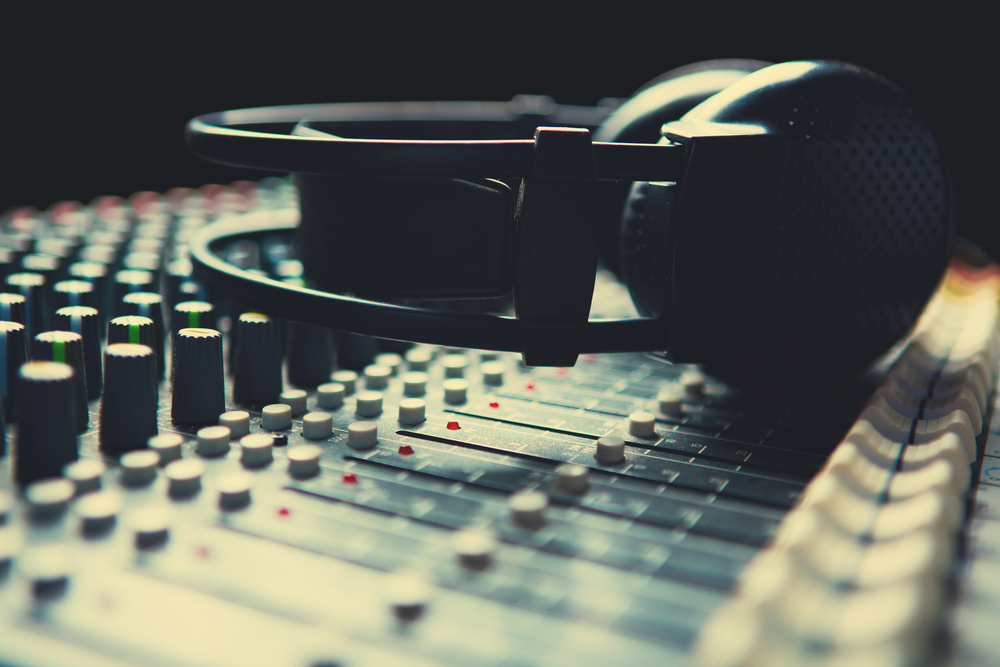
Everyone’s studio and budget are going to be different. Some people may not even have a traditional recording space. It’s important your studio suits the environment no matter where you’re setting up, and for that there are a couple of important considerations to keep in mind.
Monitors vs. Headphones
As somebody looking for studio-quality headphones, you probably already understand not everyone is in a situation where they can treat their environments for acoustics. Even if you are in one, you might not want to make that kind of commitment to producing just yet.
While a dedicated studio full of equipment is still the ideal environment to mix and master in, a quality pair of headphones will get you almost all the way there. Even the professionals are happy producing with headphones, with many touring electronic music producers today working off laptops on busses without the track ever seeing a real studio until the tour is over.
Open-Back vs. Closed-Back Headphones
Closed-back headphones are the more common type and what you probably picture when you think of over-the-ear headphones. Open-backs are very similar, but instead of a solid shell sealing the driver inside air is allowed to flow into and around the driver itself.
For mixing and mastering purposes, we recommend open-back headphones. Because they aren’t encased in anything, you’re getting the purest and most neutral response possible from the drivers. The downside of this is there’s almost no sound isolation – you’ll hear the world around you and the world will hear what’s coming out of your headphones. They also tend to be less durable and long-lasting than their closed-back counterparts, because of the increased moisture levels.
Make sure you check out our favorite open-backed headphones, the Audio-Technica ATH R70xs.
Closed-back headphones invert the pros and cons of open-backs. The driver is sealed away and protected, making for a durable and long-lasting pair of headphones. They’ve got good sound isolation too, making them great for recording booths or when you need to watch your volume. The enclosed design can affect the sound the drivers output, potentially biasing – or “coloring” – it one way or another.
When it comes to closed-back headphones, we found the AKG K872s pretty impressive for both recording and mixing purposes.
Considering the Technical Details

We touched on a few of these subjects when we went over our review criteria, but they’re more than worth diving a little deeper into. This is the foundation of evaluating headphones – whether you’re following along with our reviews or shopping on your own, being able to interpret the specifications is the only way to know what you’re getting without demoing the headphones themselves.
Impedance
An electrical engineering term, impedance is the electrical resistance of a device, usually measured in ohms. There are entire classes dedicated to explaining the full details of how this works, so to keep it simple and relevant to headphones, all you really need to know is impedance describes how much power your headphones demand.
Try to plug high impedance headphones like the DT 1990 Pros into your phone or built-in PC sound card and you’ll be lucky if you get any sound from them at all. Take a low impedance pair such as the ATH M40xs, plug it into the same sound card, and you’ll wind up with volume loud enough to hear across the room. The sensitivity rating of your headphones also plays into this dynamic, which we explain in its section.
This is one of the most important details to consider with your headphones, and the first thing you should look at when evaluating a pair. For the most part, anything over 50 to 80 ohms will need an audio interface or amplifier to work properly.
Sensitivity
Sensitivity is measured in dBs – short for decibels – and is the manufacturer’s way of trying to tell you how loud their headphones are in practice. In theory, higher sensitivity headphones including the AKG K872s can drive much higher volumes off of the same power source lower sensitivity ones can.
While you might be tempted to think more power and volume automatically means better, high sensitivity headphones can be much harsher on both your ears and the drivers they use to make sound.
Plugging a high sensitivity, low impedance pair of headphones like the into a power source that’s too much for it might cause distortion or outright blow out your drivers. On the other side of this, high impedance, low sensitivity headphones are highly sought after for mixing and mastering thanks to their ability to deliver sustained and quality sound without distortion. The ATH R70xs are a great example of this.
Keep in mind there’s no set standard for how to measure sensitivity, and numbers between different manufacturers can be hard to compare.
Frequency Response
Presented as a range of numbers, your frequency response will tell you the range of frequencies your headphones can actually output. It’s established the average range of human hearing covers from 20Hz (short for hertz) to 20kHz (that’s 20,000Hz). As we age, the upper limit of this will lower to an average of 15kHz-17kHz.
This spec may include a plus-or-minus symbol as well, indicating how much the response varies. You want this number as close to zero as possible – also known as a ‘flat response’ – for mixing and mastering.
We may not be able to hear frequencies lower than 20Hz, but we can feel them. That means headphones with a low-frequency response such as Sennheiser’s HD 800S can help you literally feel the bass. This is really useful if you’re trying to mix for a club or venue setting, because those inaudible bass frequencies can ruin an otherwise great mix if they’re not taken care of.
Frequencies exceeding 20kHz aren’t normally audible, and may even cause irritation for listeners. If you work with equalizers a lot, you’ll notice many of them have settings to filter out anything below 20Hz or above 18kHz – this makes sure you don’t leave any stray frequencies around you can’t hear.
Driver Type
Every pair of headphones contains two drivers. You’re probably already familiar with what they look like – all speakers are made up of at least one driver, too. These turn the electrical signals output by the sound source into sound waves by vibrating a rubber diaphragm at the right frequencies, ‘driving’ the audio with physical motion. This means your headphone driver is what creates the actual sound you’re hearing.
Dynamic
While dynamic headphones are great at delivering powerful bass and treble frequencies, the drivers themselves can influence the output, biasing your mix to your headphones specifically. They sound great and have a price to match, though, making dynamic-driver headphones like the Audio-Technica ATH R70x great for pulling double duty.
Magnetic
To avoid this you definitely want to look at magnetic or electrostatic drivers. Magnetic drivers are more accurate, but they’re also normally heavier and more expensive to achieve a similar sound quality. Still, for true to life sound, headphones with magnetic drivers like the Beyerdynamic DT 1990 Pro are the way to go.
Electrostatic drivers, unfortunately, don’t come cheap—they’re hard to find and often cost thousands of dollars, so we haven’t included any on this list. But they will provide the absolute best and most accurate audio available with headphones, so if you’re willing to shell out, the Shure KSE 1500s should meet and exceed your expectations.
Driver Diameter
The size of your driver itself plays a subtle, but still notable part in defining the sound of your headphones. Traditionally it’s been a trade-off – the larger the driver, the more powerful the bass and overall sound, but this can cause your treble frequencies to lose clarity. You can find an extreme example of this in studio monitors. The larger woofer and smaller tweeter drivers work together to produce the full range of sound.
High-end headphones pull double duty here, producing comparable quality with only a single driver that needs to fit comfortably on your ears. Most of them use very similarly sized drivers and focus on creating a particular audio profile with how the headphones themselves are built.
While all the headphones we recommend have large enough drivers for most studio work, anyone looking for a really powerful pair should check out the 56 mm drivers in the Sennheiser HD 800S.
Comfort
This is one of the more subjective qualities of headphones, which is why we recommend finding a way to demo them in person if possible. The size of your head and unique shape of your ears is going to make a huge difference in comfort potential. A headphone’s clamping force is simple in practice – it’s how tight or loose the headphones will fit on your head. A strong clamping force can wind up giving you headaches, especially if you wear glasses, and a too weak one will be hard to keep on your head.
Most sets of headphones are slightly better suited for larger or smaller heads, but everything we recommend should fit a majority of head sizes and shapes well enough. Others, like the highly-adjustable AKG K701 will be incredibly comfort even for outliers.
Safely Mixing With Headphones
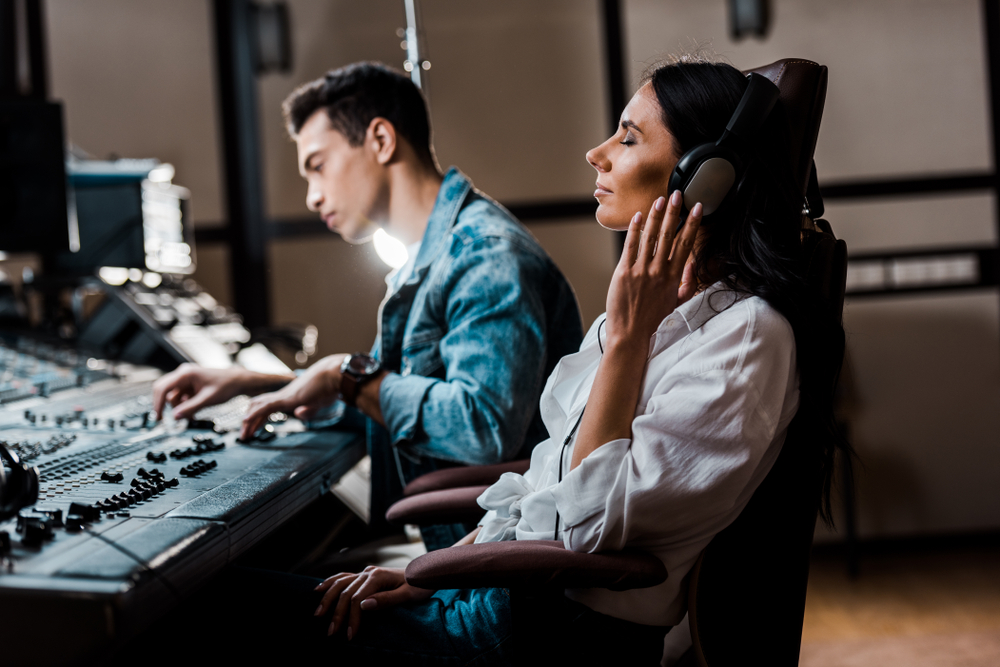
We’ve cautioned about volume throughout this article, but the importance of taking it seriously really can’t be stressed enough. As somebody interested in working with audio, your ears are precious tools you only get one set of. Research has shown that exposing yourself to excessive dBs for even a few minutes can cause permanent damage.
Damage to your ears doesn’t always come all at once – it builds up over time with exposure to dangerous noise levels. By the time you notice you’ve damaged your hearing it may be too late to prevent entirely. We’ve got a few tips here to help you take precautions now, so you can rely on your ears picking up fine details for years to come.
- Leave plenty of headroom in your mixer – keep the volume no louder than a casual conversation.
- If you connect through an amplifier or a port on your speakers, always check the amplifier’s volume before putting your headphones on.
- Take regular breaks from producing with headphones. This also helps with ear fatigue, which builds up over time and can make mastering changes almost impossible to hear.
- Listen efficiently – consider pausing playback of your track when not actively working on it to keep your brain from getting too used to the sound and tuning it out.
- Especially with high-powered headphones, use limiters and equalizers in your set up to make sure mistakes or glitches don’t unintentionally output painfully high decibels.
- You should never have a reason to exceed 100 dB while mixing and mastering with headphones.
Final Thoughts
You might find it hard to believe, but we’ve scarcely scratched the surface on this topic. If you’re still interested in learning more about high-end headphones, you could spend a lifetime digging into enthusiast content, comparing response curves and stereo imagery down to the tiniest variations.
The days where headphones could be completely written off when facing down a set of studio monitors are long gone, and if you ask us, that’s an awesome thing to be able to say. We hope we’ve been able to help you make a decision on the right reference headphones for you.


